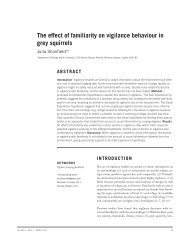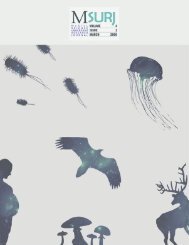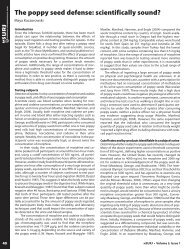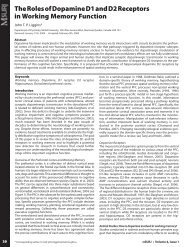the entire issue - McGill Science Undergraduate Research Journal ...
the entire issue - McGill Science Undergraduate Research Journal ...
the entire issue - McGill Science Undergraduate Research Journal ...
You also want an ePaper? Increase the reach of your titles
YUMPU automatically turns print PDFs into web optimized ePapers that Google loves.
Studying a poxvirus gene capture model through recombination and reactivation<br />
All PCR products were verified by gel electrophoresis and purified<br />
using spin columns (Fermentas).<br />
using<br />
Plaque Assay Using Crystal Violet Staining<br />
All viruses were titered by infecting mycoplasma-free African green<br />
monkey kidney epi<strong>the</strong>lial (BSC40) cells in six well culture plates with<br />
1mL of ten-fold dilutions (10-1 to 10-7) of virus. Titer plates were<br />
cultured for 1 day at 37°C to allow for plaque formation and <strong>the</strong>n<br />
stained using crystal violet. To stain, cell medium was removed and<br />
<strong>the</strong>n crystal violet was added at room temperature for 30 minutes.<br />
The stain was removed by rinsing plates with distilled water. Virus<br />
titer in plaque forming units (PFU) was calculated by selecting <strong>the</strong><br />
well that contains approximately 10-20 plaques and <strong>the</strong>n accounting<br />
for <strong>the</strong> dilution. For example, if <strong>the</strong> 10-4 dilution well had 10-20<br />
plaques, <strong>the</strong>n virus titer would be 105 PFU/ mL considering that cells<br />
were infected with 1mL of virus.<br />
Active Recombination: Live Virus Recombination<br />
Mycoplasma-free BSC40 cells were cultured in Minimal Essential Medium<br />
(MEM, Life Technologies), which was supplemented with 5% fetal<br />
bovine serum, 1% nonessential amino acids, 1% l-glutamine, and<br />
1% antibiotic at 37°C. These cells were infected with VACV (Western<br />
Reserve strain) at a multiplicity of infection of one for 1 hour in phosphobuffered<br />
saline (PBS) at 37°C, which is enough time for <strong>the</strong> majority<br />
of cells to become infected. As a negative control, BSC40 cells were<br />
also mock infected with PBS for 1 hour at 37°C. VACV infected cells<br />
were <strong>the</strong>n transfected with ei<strong>the</strong>r of <strong>the</strong> PCR constructs using <strong>the</strong> following<br />
protocol. DNA and Lipofectamine 2000 transfection reagent<br />
(Invitrogen) were incubated separately in minimal serum medium<br />
(Opti-MEM, Life Technologies) for 5 minutes at room temperature<br />
and <strong>the</strong>n gently added toge<strong>the</strong>r and incubated for an additional 20<br />
minutes at room temperature. PBS was removed from <strong>the</strong> cells and<br />
<strong>the</strong>n <strong>the</strong> transfection mixture was added, along with MEM, immediately<br />
1 hour after <strong>the</strong> VACV infection period. Cells were transfected<br />
for 1 hour at 37°C. These time frames were chosen based on work<br />
carried out by G. McFadden et al., which showed that replication and<br />
recombination occur concurrently during <strong>the</strong> first phase of <strong>the</strong> VACV<br />
replication (replication persists up to 6-8 hours post-infection) (2).<br />
The transfection mixture was <strong>the</strong>n removed and fresh medium was<br />
added. Cells were cultured at 37°C for 1 day to allow for viral replication<br />
and <strong>the</strong>n recombinants were selected for by adding 1 X mycophenolic<br />
acid (MPA) (Fig. 2).<br />
Recombinant virus was cloned and purified by re-plating in <strong>the</strong> presence<br />
of 1 X MPA three additional times, which ensures elimination of<br />
wild type VACV. To approximate recombination frequency, plaque assays<br />
were performed on virus samples taken from <strong>the</strong> initial round of<br />
MPA selection. Total virus (recombinant + non-recombinant) was determined<br />
by titering samples from transfected cells that were plated<br />
without drug. Approximate recombination frequency was calculated<br />
Passive Recombination: VACV Reactivation Using a<br />
Helper Poxvirus<br />
Poxvirus DNA alone is not infectious because it does not have access<br />
to ei<strong>the</strong>r viral or cellular DNA replication machinery. Passive recombination<br />
is a reactivation strategy where new VACV is produced<br />
from viral genomic DNA. Yao et al. showed that VACV DNA could be<br />
reactivated into live virus if <strong>the</strong> cell is infected with ano<strong>the</strong>r helper<br />
poxvirus (4). The helper poxvirus provides all necessary replication<br />
machinery. Fur<strong>the</strong>rmore, since VACV can be reactivated from<br />
a series of overlapping DNA fragments, recombination should also<br />
occur between a foreign PCR product with homology to <strong>the</strong> VACV<br />
genome and <strong>the</strong> o<strong>the</strong>r corresponding VACV fragments during reactivation<br />
(Fig. 3). The PCR product simply resembles ano<strong>the</strong>r fragment<br />
of viral DNA if significant homology is present. We tested whe<strong>the</strong>r<br />
recombinants could be produced if <strong>the</strong> PCR product did not have any<br />
homology. This allowed us to investigate whe<strong>the</strong>r gene capture is a<br />
“passive” process and whe<strong>the</strong>r it could have occurred while <strong>the</strong> virus<br />
was inactivated (e.g. by UV light) within a host cell. We also investigated<br />
whe<strong>the</strong>r a double stranded break promotes recombination, by<br />
digesting VACV DNA with NotI before transfection (Fig. 3).<br />
Fig. 2<br />
(A) Active recombination system method using BSC40 cells. Only<br />
recombinant VACV containing <strong>the</strong> YFP/gpt fusion gene can survive<br />
in <strong>the</strong> presence of MPA.<br />
(B) From top left to right: mock infected BSC40 cells; VACV (strain<br />
WR) infected BSC40 cells cultured for 3 days with MPA; VACV infected<br />
BSC40 cells transfected with PCR product B (gpt, no NotI site<br />
homology) with and without MPA selection; VACV infected BSC40<br />
cells transfected with PCR product A (gpt/NotI, 20 base pairs homology)<br />
with and without MPA selection.<br />
20<br />
<strong>McGill</strong> <strong>Science</strong> <strong>Undergraduate</strong> <strong>Research</strong> <strong>Journal</strong> - msurj.mcgill.ca









